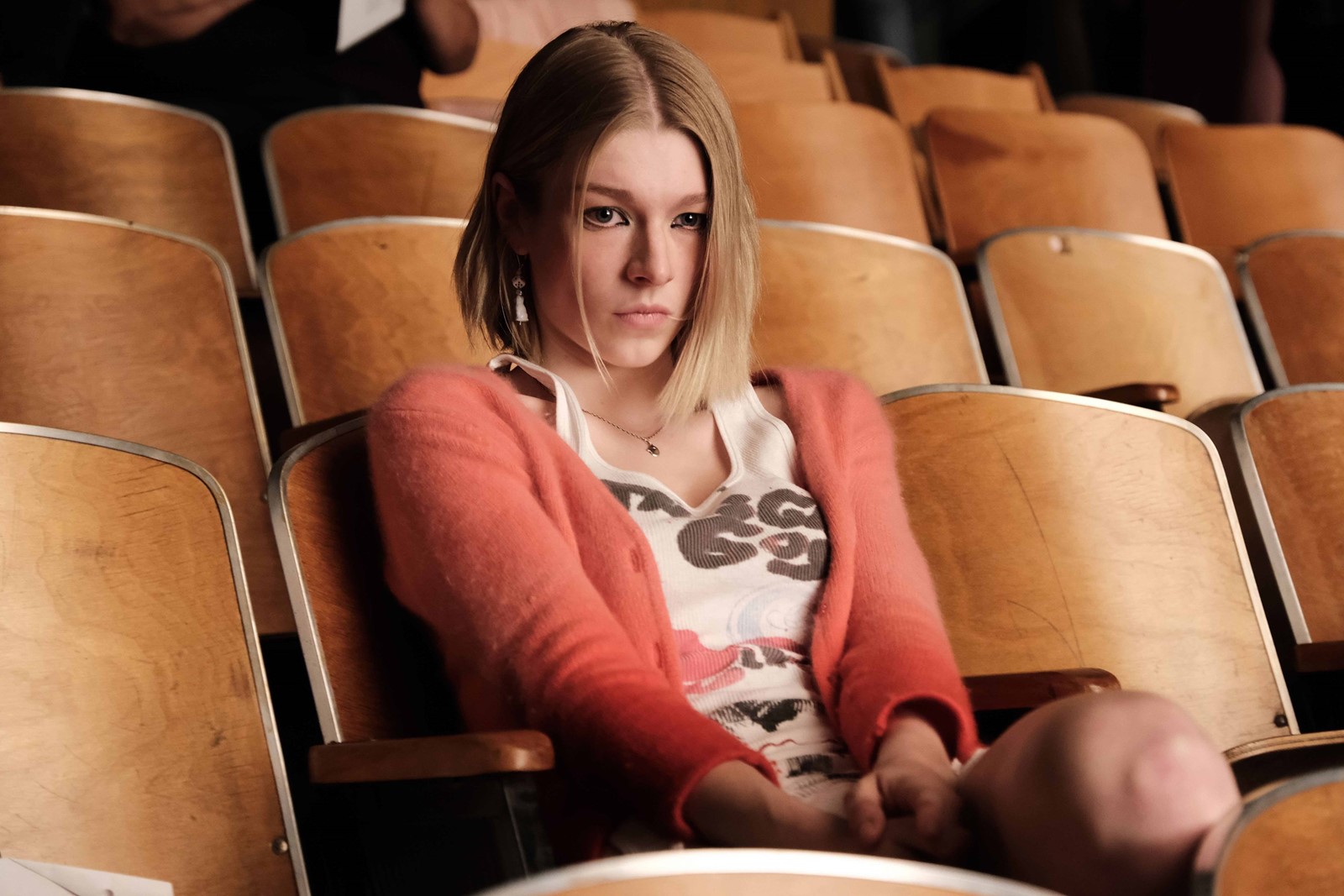This excerpt is taken from Euphoria Fashion by Heidi Bivens. This essay, Memes, Moods and Miu Miu Eras, is by Biz Sherbert.
Every Sunday night during the rollout of Euphoria, season two, I lie in my bed and scroll through hot takes of the latest episode. The take-makers call to me like screen sirens, promising to reveal the hidden meaning behind Cassie’s color palette, explaining why it matters that Nate’s only wearing black and navy shirts this season, or asking me to really think about how the fuck Lexi Howard can afford to wear Miu Miu to high school. I watch the TikToks, I read the Tweets, I tap through the stories, and I arrive at next week’s episode equipped with shiny, fragile insights around the symbolism of the costumes on screen. Some of this content stream is chopped and screwed from cast and crew interviews, but it all feels much more urgent and conspiratorial, and honestly on-brand for the Gen Z-ness of it all, when fun is fact-ified and delivered by a random on TikTok, their pupils reflecting the circular glow of a ring light.
The Euphoria costume memes hit even quicker, spawning across social media before the episode credits have time to roll. Even if a meme isn’t specifically about what the characters are wearing, it always is, in a way. A still of Cassie hiding from Maddy in a bathtub wouldn’t be as funny without the contrast between the dingy shower curtain and Cassie’s carefully selected blue ruched mini dress and white patent leather heels. There’s a forever-joke online that real-life teenagers at a real-life American high school would never wear what the make-believe teenagers at “Euphoria High” wear (if they did, they would be dress-coded into oblivion). But rating the overall success of a look on its site-specific wearability feels outdated when a look today is most successful when it can be described simply as a “mood.” A mood is by definition incorporeal, meaning you can channel Cassie’s full-blown school bathroom breakdown in a cornflower country music star dress, when really you’re just feeling a little unhinged and wearing a touch of blue eyeshadow.
This idea, that Euphoria costumes are “unrealistic,” comes up a lot. It’s why the “Euphoria High” meme was so successful: if you watched the show and had ever set foot inside literally any high school, you felt like you were in on the joke. That’s what fuels the online Euphoria takes too – feeling like you’re in on something – if not a joke, then a reference, a meaning, a meaning within a meaning. For example, this year was a Miu Miu year – their pleated micro mini broke the internet as the skirt passed through an infinite loop of editorial sets and influencer shoots. Season two was also Lexi’s Miu Miu year (or semester, at least), a detail noted online as soon as she appeared on screen wearing the brand. There’s that same conspiratorial satisfaction in clocking Lexi’s “Miu Miu era” and knowing what it means to be in one’s Miu Miu era (and knowing what it means that Lexi’s older sister, Cassie, is wearing Miu Miu’s older sister, Prada), or in identifying that Kat’s party dress was made by Mimi Wade, your personal favourite still-kind-of-underground designer for kind-of- weird “It girls.” Knowing where the clothes come from makes the characters feel less realistic, reinforcing what we already know – that teenagers usually don’t loiter in front of their lockers in designer clothes. But it also makes the characters feel more real, because you’ve seen these clothes somewhere in your own world, on your Instagram feed or on the cover of a magazine.

Despite our sleuthing, take-making, and scientific evaluation of looks on a sliding scale of slutty-realism, we expect the students of “Euphoria High” to dutifully slay – for every outfit to instantly achieve the iconic status of this year’s Halloween costume. The bar here was, of course, set by Maddy’s purple I.AM.GIA set from season one, which seemed to change our collective brain chemistry, igniting a fire for Y2K fierceness in its most potent form. Euphoria slays bring us closer to a mood – whether that’s confidence, hopelessness, desperation, freedom, addiction, or that feeling you get when you’re dressed like a hooker and nobody likes you. They introduce us to what’s hot and ask us to think more deeply about why, and we keep watching to see how high that bar can be raised.
In the penultimate episode of season two, Cassie looks great, but she doesn’t look right. She walks through school stuck to Nate, pretty in pink and just so, so wrong. Her getup is nauseatingly femme; her heart-shaped necklace sits lonely and obvious on her chest; her hair is too straight; her eyes are weighed down by the heavy glisten of her makeup. Cassie doesn’t say anything in this scene. She doesn’t need to. She’s a doll brought to life through the commitment of her daily full-body makeover routine and the dream of Nate’s hand around hers, a male fantasy animated by female obsession. We know all of this not through dialogue, but through costuming.

Unlike Cassie the fembot, quietly leaking sadness, Maddy is the life-of-the-party black widow in a cut-out mini dress and long gloves in the first episode of season two. It’s a look that could kill, or at least act as armour as she beats both fists on a bathroom door (that Cassie’s secretly locked behind). Like Cassie’s hair in the final episode, Maddy’s is pin straight, but it’s scraped back with a plastic zig-zag headband – the kind you might find in the dollar store and wouldn’t necessarily think to wear with your hottest going-out, post-breakup outfit. But Maddy would. Her necklace bears her own name in thick silver script, while Cassie’s necklace is engraved with the classically generic femme calling card, “Please Return to Tiffany & Co.” Planted in the details of her look are pieces of who Maddy already knows she is, while the girl Cassie thinks she should be wavers in her fragile, clashing pinks. Euphoria’s costumes are embedded with clues that signify something deeper about who we are and how we feel, and social media gives us a stage to have a good time figuring them out.
Euphoria Fashion by Heidi Bivens is published by A24, and is out now.






